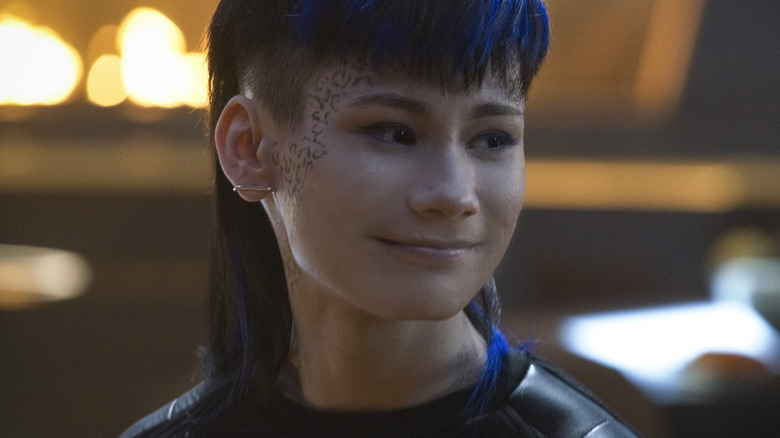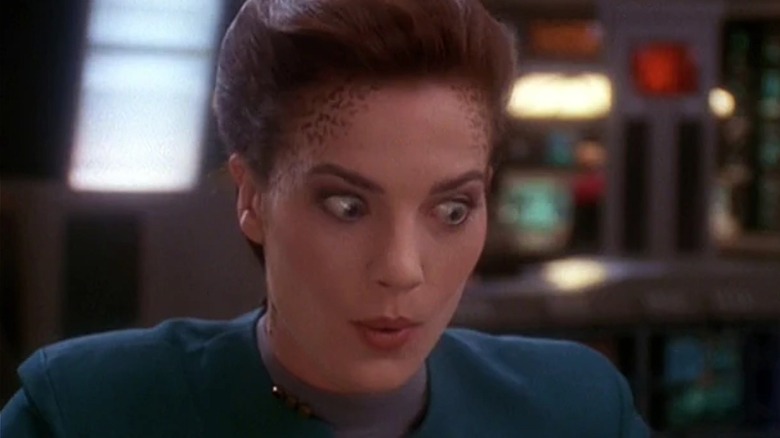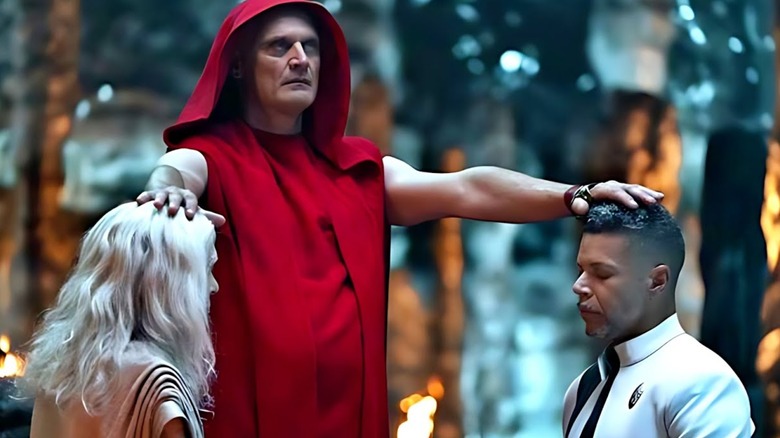Star Trek: What Is A Trill?
The Trill, one of the more fascinating species in the "Star Trek" franchise, are a race of humanoids who evolved to have a unique and highly ritualized relationship with a parasitic sentient life form. By allowing an elite group of their people to "join" with these symbionts, the Trill have the unique ability to generationally connect the memories and experiences of each host, allowing them to pass down their wisdom. As the Trill Odan's male host (Franc Luz) explains in the "Star Trek: The Next Generation" episode "The Host," "The Trill are a joined species. A host and a symbiont, and in this fashion we have survived for millennia."
Although it's possible for a Trill to join temporarily with a non-Trill species in an emergency situation, these events almost always lead to deterioration in the host body. When Will Riker (Jonathan Frakes) temporarily hosts the Odan symbiont, his immune system is badly affected, a condition Beverly Crusher (Gates McFadden) refers to as "classic rejection syndrome." A notable exception is Adira's (Blu del Barrio) joining with Gray Tal (Ian Alexander) in the canon-altering "Star Trek: Discovery" episode "Forget-Me-Not," a joining that ends when Hugh Culber (Wilson Cruz) transfers Gray's symbiont into an organically engineered android known as a golem in "Choose to Live."
Up until the Enterprise-D's experience transporting Ambassador Odan to mediate a dispute in 2367, the Trill don't seem to have advertised the fact that some members of their species carried a symbiont. Despite being a doctor with a wide knowledge of non-human species, Beverly Crusher doesn't understand Odan is the parasite when she discovers it in "The Host" and seems genuinely taken aback when Odan reveals his body is simply the host.
The Trill look changed over time
Because "The Host" primarily focused on Crusher's efforts to save the Odan symbiont and the complicated romance between the Trill and the Enterprise doc, "Star Trek: The Next Generation" didn't offer much aside from basic information on the Trill. Fortunately, "Star Trek: Deep Space Nine" and "Star Trek: Discovery" would expand on the Trill species, giving Trekkies a closer look at the Trill's joinings, delving into Trill psychology, and even revealing a few things about the Trill homeworld. Ultimately, this meant a nearly complete reimagining of the race.
One of the most glaring examples of the Trill transformation is their physiology. The face of the male Trill host featured in "The Next Generation" features prominent facial ridges — ridges that are also seen in the female Trill host Kareel Odan (Nicole Orth-Pallavicini). However, the production team behind "Deep Space Nine" would ultimately decide to scrap the ridges, something David Carson acknowledged this fact in Mark A. Altman's "The Fifty-Year Mission: The Complete, Uncensored, and Unauthorized Oral History of Star Trek: The Next 25 Years from The Next Generation to J. J. Abrams."
According to Carson, the screen tests for those ridges showed that aesthetically, they simply didn't do "Deep Space Nine" actor Terry Farrell, who played Jadzia Dax, any favors. "When we first started shooting her, she had these old prosthetic lumps on her face," Carson recalled. "But frankly they did not add to her undeniable attractiveness, so everybody decided that her face should be left alone and spots should be added, which went under the collar of her costume."
The Trill species lore evolved greatly over time
"Deep Space Nine" would also expand on the Trill lore extensively beginning with a few major retcons. First, the fact that the Federation didn't seem to be familiar with the Trill's joined nature seems to suggest a huge Star Trek mistake in Commander Benjamin Sisko (Avery Brooks) and Curzon Dax's (Frank Owen Smith) long friendship established in "Emissary." According to "Deep Space Nine," this friendship that dates back more than a decade before Crusher first learns of the species.
But an even bigger retcon is the Trill's relationship with the transporter, which Odan insists would kill him — a fact directly contradicted by Jadzia Dax's frequent transporter use in "Deep Space Nine." As Trek writer Ronald D. Moore confessed in a 1997 AOL chat, "The Trill were not supposed to go through transporters and we slid by it (like the original Trill makeup)." A third "Deep Space Nine" retcon seems to come in the species' cultural taboos against new hosts associating with their old friends and lovers, although the argument could be made that like Jadzia Dax, Udan might have simply not taken those rules all that seriously.
"Deep Space Nine" also expanded on the Trill homeworld and joining process by developing the interconnected milky protein baths in the underground Caves of Mak'ala as a natural habitat for the symbionts. As seen in the "Discovery" episode "Forget-Me-Not," submersion in those pools allows individuals to telepathically communicate with each other and the symbionts within them.


